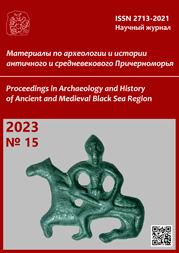Ornamental circles on the shrouds of the frescoes in the Cathedral of the Nativity of the Virgin, the St. Ferapont Monastery: sacral symbols and liturgical practices visualized
Ornamental circles on the shrouds of the frescoes in the Cathedral of the Nativity of the Virgin, the St. Ferapont Monastery: sacral symbols and liturgical practices visualized
Author(s): O.V. SilinaSubject(s): History, Archaeology, 16th Century
Published by: Нижневартовский государственный университет
Keywords: the Cathedral of the Nativity of the Virgin; frescoes; Dionysius; hanging shrouds; circle with ornament; daily cycle of services; Byzantine hours;
Summary/Abstract: This article describes the wall-painting cycle of ornamental circles on the hanging shrouds which decorate the Cathedral of the Nativity of the Virgin in the St. Ferapont Monastery. Painted in 1502 by the artel of Dionysius, the frescoes represent the earliest extant tier of shrouds among the works of Old Russian monumental art. The iconography and symbolism of hanging shrouds in the church space are well-known, but the reasons why the ornamental circles appeared on the shrouds as well as their semantics and the idea of a special solution Dionysius had made for the tier are among insufficiently studied issues. The background tonality behind the shrouds, the compositional and rhythmic arrangement and the number of circles are analyzed. By referring to iconographic parallels in Judaic ossuaries and Old Russian sarcophagi and church decorations, the conclusion is made that the ornamental circles had the most ancient origin and the peculiar sacral significance; the unique is the conceptual solution proposed by Dionysius: the symbolism of the Byzantine liturgical hours could be reflected in his interpretation of the shrouds.
Journal: Материалы по археологии и истории античного и средневекового Причерноморья
- Issue Year: 2023
- Issue No: 15
- Page Range: 908-943
- Page Count: 36
- Language: English

